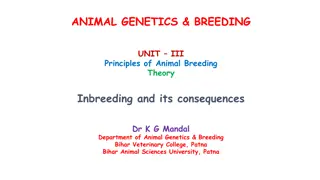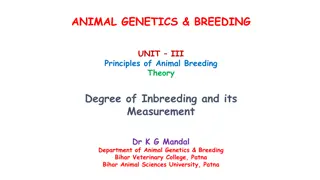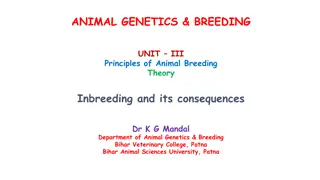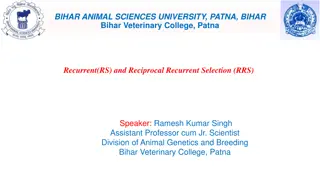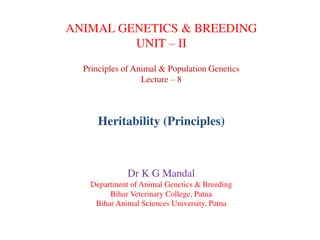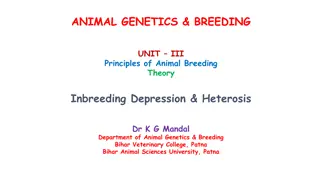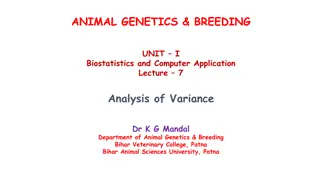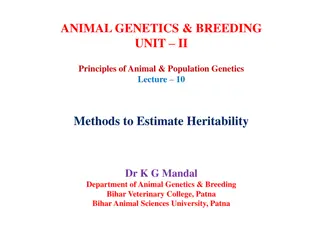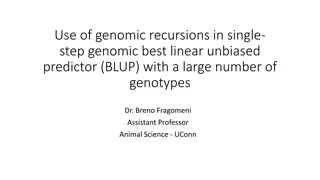Understanding Degree of Inbreeding and its Measurement in Animal Genetics and Breeding
Degree of inbreeding in animals is the extent to which genes are identical by descent within an individual. The coefficient of inbreeding, denoted by F, measures this degree and represents the increase in homozygosity in offspring from closely related matings. Two sources of homozygosity are genes alike in state and genes identical by descent. Inbreeding coefficient helps quantify the probability of alleles being identical by descent. Understanding and measuring inbreeding is crucial in animal genetics and breeding to manage genetic diversity and health within populations.
Download Presentation

Please find below an Image/Link to download the presentation.
The content on the website is provided AS IS for your information and personal use only. It may not be sold, licensed, or shared on other websites without obtaining consent from the author. Download presentation by click this link. If you encounter any issues during the download, it is possible that the publisher has removed the file from their server.
E N D
Presentation Transcript
ANIMAL GENETICS & BREEDING UNIT III Principles of Animal Breeding Theory Degree of Inbreeding and its Measurement Dr K G Mandal Department of Animal Genetics & Breeding Bihar Veterinary College, Patna Bihar Animal Sciences University, Patna
Degree of Inbreeding & its Measurement Degree of inbreeding: The extent to which an individual carry the genes identical by descent is the degree of inbreeding or intensity of inbreeding. The degree of inbreeding of an individual depends upon the degree of relationship between the parents of the inbred individual. Prof. Sewall Wright (1921) proposed the method to measure the degree of inbreeding or intensity of inbreeding which is called the coefficient of inbreeding. The coefficient of inbreeding is denoted by F.
Coefficient of Inbreeding: It represents the probable increase of homozygosity in the offspring resulting from the mating of individuals which are more closely related than the average relationship of the population concerned. Inbreeding coefficient is the probability that the two alleles at a given locus of an individual are identical by descent. Homozygosity of allelic genes at a locus may occur from two sources viz. (i) due to genes alike in state (ii) due to genes identical by descent
Genes alike in state means that two similar genes at a given locus may arise due to: (i) Mutation of one gene or other, or (ii) Two genes may be drawn at random the population and happened to be Genes identical by descent means two allelic genes at a given locus of an individual have originated due to replication of only one and the same gene from previous generation. from homozygous.
The individual carrying the genes identical by descent at a given locus is called autozygote or identical homozygote and genes are autozygous. Concept to quantify inbreeding coefficient, F : Consider the following pedigree of half-sib mating: A is a common ancestor, B&C are half-sibs and X is an inbred. B (A1A1 or A2A2) X C Probability that X is homozygous for A1A1 = x =1/16 Probability that X is homozygous for A2A2 = x =1/16 Probability that X is either A1A1 or A2A2 = 2x? A (A1A2) ?? =? ? = 0.125
Properties of inbreeding coefficient: 1. Inbreeding coefficient ranges from 0 to 1 in terms of proportion or 0 to 100 %. 2. As the value of F increases, the relative proportion of heterozygous decreases which is represented by (1-F). This (1-F) is known as panmictic index. Thus, panmictic index, P = 1-F.
Methods for calculation of inbreeding coefficient: (i) Path coefficient method developed by Sewall Wright (1921). (ii) Co-ancestory method developed by Malecot (1948). (iii) Variance covariance method derived from path coefficient method.
Principles for estimation of inbreeding coefficient through path coefficient method: Formula proposed by S. Wright (1921) for computation of inbreeding Coefficient, F, of an inbred individual, X, is as follow: Fx = ( ) n1+n2+1+ ( ) n1+n2+1 (1+ FA) = ( ) n1+n2+1 (1+ FA) B n1 X C n2 A
Where, FX = inbreeding coefficient of the individual x . n1 = number of generations from one parent to the common ancestor (A). n2 = number of generations from another parent to the common ancestor (A). FA =Inbreeding coefficient of the common ancestor (A). = Summation over all the paths connecting sire and dam of inbred individual through common ancestor and over all the common ancestors, if the common ancestors are more than one.
Steps involved: 1. The pedigree should be presented in arrow diagram. 2. The inbred individual, its parents and common ancestors are to be located. 3. The values of n1 and n2 are to be obtained. 4. If the common ancestor is inbred, its inbreeding is to be calculated at first.
Rules for tracing paths: 1. The path should connect the two parents of the inbred individual either directly or through common ancestor. 2. The path starting from one parent first then goes backward to the common ancestor and then comes forward to the second parent of the inbred individual. 3. No individual in the path is connected more than one time. Thus a path cannot pass through the same individual twice.
Example: X S D A 2 3 1 Some important points: 1. one(1) is common ancestor for A not for X . Why? 2. As per principle, path starts from one parent (S) of inbred individual (X) going back to the common ancestor and ends at other parent (D) of inbred and no individual will be present twice on the same path. 3. Accordingly, correct path is SAD not SA213AD. In second path A has appeared twice. Hence, SA213AD is not a correct path.
4. A is a common ancestor for X . 5.The common ancestor (A) of X is inbred. Hence, for calculation of FX ,the inbreeding coefficient of common ancestor (FA ) is to be calculated at first. 6. The value of FA is to be put in the formula for calculation of FX.




